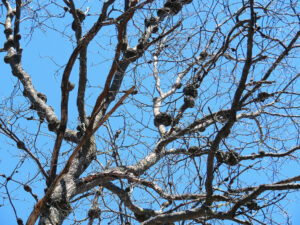By Linda Williams, DNR forest health specialist, Woodruff;
Linda.Williams@wisconsin.gov or 920-360-0665

It is often easier to spot large Phomopsis galls before leaves come out in the spring.
Phomopsis galls are large woody swellings on the branches or main stem caused by a fungus. Across Wisconsin, Phomopsis galls can grow on hickory, especially bitternut hickory. However, in some areas of Wisconsin, they can occur on northern red oak.
Northern red oaks sometimes have hundreds of Phomopsis galls on the branches, ranging from as small as a tennis ball to as large as a basketball. There are often only a few scattered trees in an area with Phomopsis galls, and heavily galled trees may grow next to other trees with no galls. Genetic variability is suspected to play a role in the susceptibility of individual trees; however, a lot remains unknown about this fungus.

Eventually, trees with many Phomopsis galls are likely to decline. Leaves become clumped, smaller, fewer and off-color before the tree dies.
Galls grow slowly, and heavily infected trees can survive for many years. Eventually, large galls will disrupt the tree’s ability to transport water to its branches. After decades of living with the galls, trees can begin to decline. Leaves on declining trees will be smaller than normal, slightly off-color and might appear to grow in clumps. Dead leaves will remain on the tree for several months after the tree dies.
There is no known treatment for Phomopsis galls other than pruning and disposing of them. Many people choose to live with them. When marking a stand for thinning, galled trees are generally not considered at high risk of failure before the next entry because the trees can live for decades before declining.
During planned thinnings, heavily galled trees already exhibiting dieback and beginning to drop large galls to the ground could be removed.
Other things can cause woody galls on oaks, including horned oak gall and gouty oak gall. These are caused by non-stinging gall wasps, bacterial crown gall and burls.
